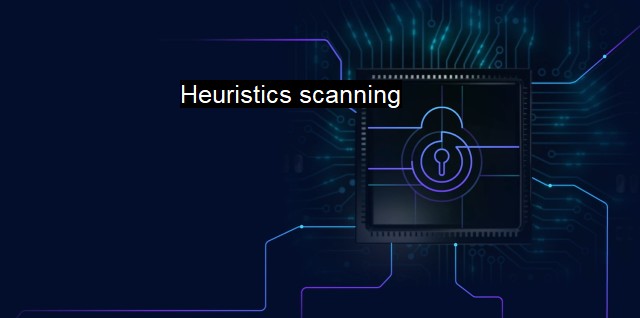What is Heuristics scanning?
Heuristics Scanning: Intelligence vs Signature-Based Antivirus Detection for Identifying Unknown Viruses and Malware
Heuristics scanning, in the context of cybersecurity and antivirus protocols, addresses a pertinent aspect in security – probabilistic judgment, also known as "educated guess," that supports rapid decisions.Heuristics scanning constitutes an advanced assessment implemented within antivirus software, scrutinizing behaviors of new programs or files to determine their threat level. The process involves analysis and prediction rather than direct searching for a virus' specific identifiers or signatures. It/heuristics scanning is lauded for its ability to recognize and proactively fight against new threats that haven't been previously recorded in virus databases.
Such effectiveness is ensured as heuristics scanning grounds on sophisticated algorithms that focus on the structure and characteristics of files, reflecting whether they contain malicious code. The files are observed against a set of rules representing the possible traits of malware. Therefore, instead of matching precise virus signatures, heuristic scanning flags behaviors or code snippets that are "malware-like," providing security amidst previously unknown threats, an ominous challenge in contemporary cybersecurity.
Remarkably, it is essential to underscore, amidst immense complexities of the dynamically evolving digital architecture and expanding landscape of cyber threats, zeroing down on heuristics scanning for security provision. Traditionally firewall, intrusion prevention systems, and antivirus received paramount focus as a trio of protection. most of the signature-based or rule-based systems seem to falter for rapidly mutating attack vectors and sophisticated types of malware, presenting a stumbling block in cybersecurity.
Addressing the quagmire as the herald of a new generation of malware detection mechanisms, advanced heuristics goes beyond traditional rules or signature-based systems by predicting unauthorized activities. Actually, it behaves like a cryptographer who predicts a coded message without knowing the decryption key, adding layers to cybersecurity infrastructure.
Consider trojans as an archetype – featuring endless variations, rendering it impossible to maintain an update enough database of all possible signatures. Trojans portray innocuous files to trick users into unleashing their hoard of threats. Antivirus software based solely on the conventional signature-based method will unequivocally fail to communicate these threats. Heuristic scanning proves as an invaluable assistant here as it monitors suspect behaviors, unraveling the disguising trojans’ threats and mitigating them.
Heuristics remain a vital layer of cybersecurity infrastructure, especially in enterprise-level organisations, with burgeoning usage of online applications, each bringing a potential vulnerability gate. Since heuristics doesn't solely depend on known virus signatures databases, it allows an effective continuous secure workflow, even if the threat databases lag in remaining updated about the newest malware symptoms.
Often designed to function on tiers of rules, the parser, the first tier, analyzes all the code disregarding its safety in order to detect suspicious code structures. The emulator, constituting the second rule tier, studies and replicates the code to quantify any hidden evil intentions. With increasing focus on deep learning, the heuristic process's accuracy and agility continue to improve. Still, they suffer from their quota of critiques, more notably, false positives, coupling benign files as risky. Such false positives might generate end-user annoyance and loss of system productivity.
The potential of heuristics scanning demands a due acknowledgment whereby enabling it in antivirus settings could virtually play a subtle savior in zero-hour threats. a balance or mitigation strategy must exist to address the iterative problem of user-end distractions due to false positives.
In sum, heuristics scanning significantly deepens the dimensions of security precautions, empowers proactive ideaologies, and shatters the proverbial idea of over-dependence on regularly updated virus databases. Thus, for innovating with digitization, escaping heuristic scanning carelessness serves a pivotal point in bolstering cybersecurity.

Heuristics scanning FAQs
What is heuristics scanning?
Heuristics scanning is a cybersecurity technique used by antivirus software to detect new and unknown malware threats by analyzing their behavior and characteristics rather than relying solely on signature-based detection.How does heuristics scanning work?
Heuristics scanning works by using a set of rules and algorithms to detect malware by analyzing its behavior, code, and other characteristics. It looks for suspicious activities such as attempts to modify critical system files, create new processes, or communicate with malicious web addresses. If a file exhibits several suspicious characteristics, it is flagged as potentially malicious and subjected to further scrutiny.What are the benefits of heuristics scanning?
Heuristics scanning offers several benefits over traditional signature-based antivirus solutions. It can detect unknown and zero-day malware threats that do not have signature files. It can also detect polymorphic and encrypted malware that change their code to evade detection. Additionally, heuristics scanning can be used as an additional layer of defense alongside signature-based antivirus software.Are there any limitations to heuristics scanning?
Yes, heuristics scanning has some limitations. It can produce false positives when legitimate software exhibits a behavior that matches a heuristic rule. This can result in the quarantine or deletion of a harmless file. Heuristics scanning can also be resource-intensive and slow down system performance. Additionally, some advanced malware can evade heuristic detection by mimicking legitimate behavior or using code obfuscation techniques.| | A | | | B | | | C | | | D | | | E | | | F | | | G | | | H | | | I | | | J | | | K | | | L | | | M | |
| | N | | | O | | | P | | | Q | | | R | | | S | | | T | | | U | | | V | | | W | | | X | | | Y | | | Z | |
| | 1 | | | 2 | | | 3 | | | 4 | | | 7 | | | 8 | | |||||||